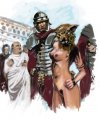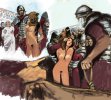Praefectus Praetorio
R.I.P. Brother of the Quill
Poena cullei (penalty of the sack) is believed to have originated about 200 BC in Rome as punishment for parricidium (parricide - killing a relative, especially a parent, committing treason, killing a ruler, or another authority figure). Its etymology from pars [equal or fellow] and cidere [kill] may imply that it originated from the pre-historic blood taboo against shedding the blood of a clansman*). Some scholars believe that the form of execution was significantly older.
Poena cullei continued sporadically until the fall of the Western Empire in the early 5th century shortly after the setting of our story. However, it continued in Byzantine law until almost the end of the first millenium. The punishment gained a revival in late medieval and early modern Germany, with late cases documented from Saxony in the early 1700s.**
As would be expected, for a gruesome and strange procedure, only intermittently used over a thousand years, there was substantial variation in the application. Although the authorities in Narbo were familiar with the Lex Pompeia of 81 BC, the legal basis for the punishment, there had not been such an execution in the memory of any there. Therefore, the author begs the indulgence of the more critical readers here if the mode of execution appears incorrect. He begs two reasons for license. First, the punishment is here not an execution since the Goth is condemned to crucifixion afterward. Secondly, the ignorance and intellectual laziness of these, provincial officials will have caused other discrepancies.
Lucius Piso, relishing his role as Ludi Magister (lit. “Master of the Game), rose to address the small gathering. “It has been judged that the Goth slave Barbara is guilt of parricidium as defined by the Lex Pompeia, and therefore is subject to the Poena Cullei, which shall be inflicted una hora et altera (one hour and another). This shortening is so that she may survive to suffer the rest of her sentence. The punishment will commence with a beating cum virgis sanguinis (lit. bloody rods. This could mean rods with red color added, or with bloodstains from previous use, or the blood drawn by them).”
Optio Mogurix directed three of his men to each grab a rod. He then had them walk slowly in a tight circle around the bound and exposed girl. The men slashed the thin, whippy rods through the air as preliminary threats. Barbara turned her head back and forth, trying to follow and anticipate the first blow. Sweat again broke out on her skin as intense fear welled up.
* The blood taboo is an ancient and complicated matter. Cultural anthropologists have found it widespread in very old, isolated societies. At its heart is the origin of all laws against hurting or killing fellows of the tribe. Interestingly, some cultures carried it so far as to forbid the shedding of the blood of a virgin by first intercourse. In these cases, the girl was ritually deflowered by a member of the neighboring tribe to avoid her new husband breaking the taboo (or something else).
**Grimm's Deutsche Rechtsalterthümer mentions two cases in which this exact penalty was inflicted, one in Cassel in I576, and the other in Saxony in I734; but he points out that these late incidents are simply enforcements, as far as was feasible, of the penalty prescribed in the Institutiones Justiniani (Institutes of Justinian), the old, lapsed Byzantine form of Poena Cullei. The magistrates there probably picked up the description from the Etymologiae ("Origins"), an etymological encyclopedia compiled by Isidore of Seville after 600 AD and widely known in the Middle Ages.
Poena cullei continued sporadically until the fall of the Western Empire in the early 5th century shortly after the setting of our story. However, it continued in Byzantine law until almost the end of the first millenium. The punishment gained a revival in late medieval and early modern Germany, with late cases documented from Saxony in the early 1700s.**
As would be expected, for a gruesome and strange procedure, only intermittently used over a thousand years, there was substantial variation in the application. Although the authorities in Narbo were familiar with the Lex Pompeia of 81 BC, the legal basis for the punishment, there had not been such an execution in the memory of any there. Therefore, the author begs the indulgence of the more critical readers here if the mode of execution appears incorrect. He begs two reasons for license. First, the punishment is here not an execution since the Goth is condemned to crucifixion afterward. Secondly, the ignorance and intellectual laziness of these, provincial officials will have caused other discrepancies.
Lucius Piso, relishing his role as Ludi Magister (lit. “Master of the Game), rose to address the small gathering. “It has been judged that the Goth slave Barbara is guilt of parricidium as defined by the Lex Pompeia, and therefore is subject to the Poena Cullei, which shall be inflicted una hora et altera (one hour and another). This shortening is so that she may survive to suffer the rest of her sentence. The punishment will commence with a beating cum virgis sanguinis (lit. bloody rods. This could mean rods with red color added, or with bloodstains from previous use, or the blood drawn by them).”
Optio Mogurix directed three of his men to each grab a rod. He then had them walk slowly in a tight circle around the bound and exposed girl. The men slashed the thin, whippy rods through the air as preliminary threats. Barbara turned her head back and forth, trying to follow and anticipate the first blow. Sweat again broke out on her skin as intense fear welled up.
* The blood taboo is an ancient and complicated matter. Cultural anthropologists have found it widespread in very old, isolated societies. At its heart is the origin of all laws against hurting or killing fellows of the tribe. Interestingly, some cultures carried it so far as to forbid the shedding of the blood of a virgin by first intercourse. In these cases, the girl was ritually deflowered by a member of the neighboring tribe to avoid her new husband breaking the taboo (or something else).
**Grimm's Deutsche Rechtsalterthümer mentions two cases in which this exact penalty was inflicted, one in Cassel in I576, and the other in Saxony in I734; but he points out that these late incidents are simply enforcements, as far as was feasible, of the penalty prescribed in the Institutiones Justiniani (Institutes of Justinian), the old, lapsed Byzantine form of Poena Cullei. The magistrates there probably picked up the description from the Etymologiae ("Origins"), an etymological encyclopedia compiled by Isidore of Seville after 600 AD and widely known in the Middle Ages.
Last edited:







